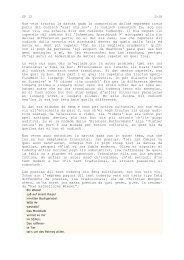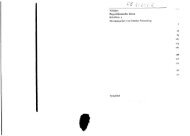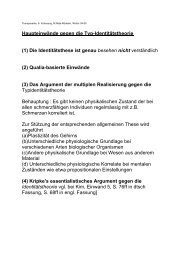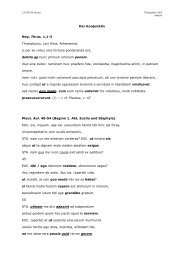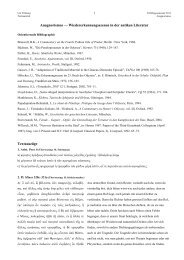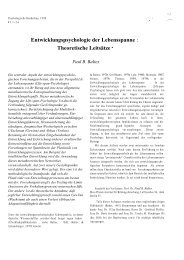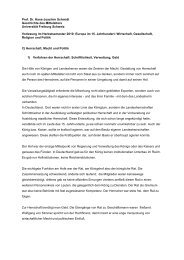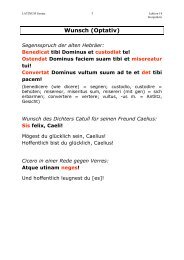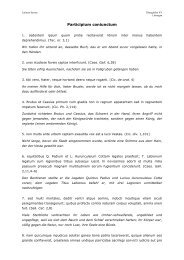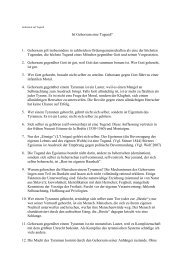NTEX_FS10_Apk_Skript_Juni_03 - Commonweb
NTEX_FS10_Apk_Skript_Juni_03 - Commonweb
NTEX_FS10_Apk_Skript_Juni_03 - Commonweb
Sie wollen auch ein ePaper? Erhöhen Sie die Reichweite Ihrer Titel.
YUMPU macht aus Druck-PDFs automatisch weboptimierte ePaper, die Google liebt.
50 FS 2010, Bern (M. Mayordomo)<br />
• Kap. 4 + 5 sind eine Doppelvision.<br />
• Der Text schreitet fort in Form von insg. fünf Lobgesängen, deren Anordnung<br />
intentional und komponiert ist:<br />
Text Form Sprecher Adressat Funktion Weiteres<br />
4,8 Trishagion 4 Lebewesen Gott Einleitung allgemein<br />
4,11 axios ei 24 Älteste Gott Würde allgemein<br />
5,9f axios ei 4 Lebewesen + 24<br />
Älteste<br />
Lamm Würde der mittlere Hymnus ist eng mit<br />
Kontext verzahnt<br />
5,12 axion estin Unzählige Engel Lamm Würde allgemein<br />
5,13f Eulogie +<br />
Amen<br />
Alle Geschöpfe Gott +<br />
Lamm<br />
Schluss<br />
allgemein<br />
2.3.1 Der Thron, der auf ihm Sitzende und alles drum herum (4,1-11)<br />
Aune, David E. The influence of Roman imperial court ceremonial on the Apocalpse of John, in:<br />
Apocalypticism, Prophecy and Magic in Early Christianity. Collected Essays (WUNT 199), Tübingen,<br />
2006, 99-119. – Böttrich, Christfried. Das ›gläserne Meer‹ in <strong>Apk</strong> 4,6/15,2, BibNot 80 (1995) 5-15. –<br />
Giblin, Charles H. From and Before the Throne: Revelation 4:5-6a integrating the imagery of Revelation<br />
4-16, CBQ 60 (1998) 500-513. – Grelot, Pierre. L'imagerie des quatre vivants symboliques, in: Études<br />
sémitiques et samaritaines, ed. Christian-Bernard Amphoux et al. (Histoire du texte biblique 4),<br />
Lausanne, 1998, 241-250. – Hall, Robert G. Living Creatures in the Midst of the Throne: Another Look<br />
at Revelation 4.6, NTS 36 (1990) 609-613. – Hasitschka, Martin. Die Priestermetaphorik der<br />
Apokalypse als Ausdruck der Verbundenheit der auf Erden lebenden und den zur Auferstehung gelangten<br />
Christen, SNTU-A 29 (2004) 179-192. – Paciorek, Piotr. Les diverses Interprétations patristiques des<br />
quatre vivants d'Ezéchiel 1,10 et de l'Apocalypse 4,6-7 jusqu'au XIIe siècle, Augustiniana 51/1-2 (2001)<br />
151-218. – * Parker, Floyd O. ›Our Lord and God‹ in Rev 4,11: Evidence for the late date of<br />
Revelation?, Biblica 82 (2001) 207-231. – Rotz, Carol J. & Du Rand, Jan A. The One Who Sits on the<br />
Throne: Towards a theory of theocentric characterisation to the Apocalypse of John, Neotestamentica 33<br />
(1999) 91-111. – Seal, David. Shouting in the Apocalypse. The influence of first-century acclamations on<br />
the praise utterances in Revelation 4:8 and 11, JETS 51 (2008) 339-352. – Stevenson, Gregory M.<br />
Conceptual Background to Golden Crown Imagery in the Apocalypse of John (4:4, 10; 14:14), JBL 114<br />
(1995) 257-272.<br />
• Mit metá tauta setzt in 4,1 deutlich ein neuer Abschnitt ein 105 . Der Sprecher wechselt;<br />
die erste Pers. Sg. bezieht sich nicht mehr auf den Parusie-Herrn, sondern auf den<br />
Seher Johannes.<br />
• Dennoch ist die Thronsaalvision eng mit den Sendschreiben verbunden 106 , etwa durch<br />
das Stichwort »Tür« (3,20; 4,1) und v.a. durch die Verheißung in 3,21 an die<br />
Siegreichen, auf den Thron zu sitzen. Der Thron bildet in Kap. 4 das zentrale<br />
architektonische Strukturelement.<br />
• Kap. 4 setzt durchgehend die Eröffnungsvision in Ezechiel 1 voraus. 107 Die<br />
auffälligsten Unterschiede sind:<br />
105 Vgl. die gleiche Wendung (»danach sah ich«) führt in 7,1; 18,1 (und 19,1: »danach hörte ich«) einen<br />
neuen Abschnitt ein. Eine Zäsur zwischen zwei Visionsteilen wird in 7,9 und 15,5 dadurch angezeigt. Zur<br />
Verwendung in der jüd. Apokalyptik vgl. äthHen (1Hen) 85,1; 89,30; syrBar 37; 53,8-<br />
106 Vgl. Schimanowski, Liturgie, 39-42.<br />
107 Zur Wirkungsgeschichte von Ezechiel in der Apokalyptik: Halperin, David J. The Faces of the chariot.<br />
Early Jewish responses to Ezekiel's vision (TSAJ 16), Tübingen, 1988. – Jonge, Henk Jan de (ed.). The Book of<br />
Ezekiel and its Influence, Aldershot: Ashgate, 2007. – Kowalski, Beate. Die Rezeption des Propheten Ezechiel<br />
in der Offenbarung des Johannes (SBB 52), Stuttgart, 2004. – Nielsen, Kirsten. Ezekiel's visionary call as<br />
prologue: from complexity and changeability to order and stability? JSOT 33 (2008) 99-114. – Ruiz, Jean-<br />
Pierre. Ezekiel in the Apocalypse. The transformation of prophetic language in Revelation 16,17-19,10 (EHS<br />
23:376), Frankfurt aM., 1989. – Sänger, Dieter (Hg.). Das Ezechielbuch in der Johannesoffenbarung (BThSt<br />
76), Neukirchen-Vluyn, 2006.<br />
[Vorlesungsmanuskript, nur für privaten Gebrauch]



